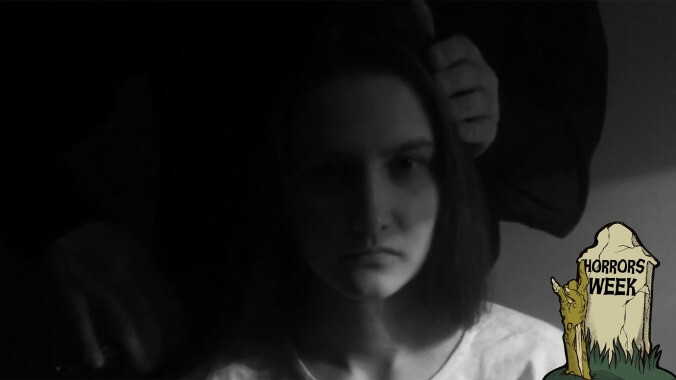These clever mobile horror games seek to emulate the real world's nastiness—misogyny and all

Every Friday, A.V. Club staffers kick off our weekly open thread for the discussion of gaming plans and recent gaming glories, but of course, the real action is down in the comments, where we invite you to answer our eternal question: What Are You Playing This Weekend?
There’s a specific subset of games that can turn my innocent, unsuspecting mobile device into a carrier of horrors previously, blissfully unknown. Blending new-school technological savvy with old-school horror tropes, it’s the hyperrealistic true crime simulator.
You’ve probably seen them on the app store: Often tucked away underneath the innocuous “puzzles” category, narrative adventures like Kaigan Games’ Sara Is Missing and Guts United’s I Am Innocent combine detective work and, in some cases, puzzle elements in order to tell the story of a mysterious, often complicated crime, all couched in intentionally realistic-looking phone-like interfaces. These real-time adventures employ very convincing text messages (complete with flickering, anxiety-inducing “Oh shit, the other person is typing” bubble technology), voice mails, simulated phone calls, video clips, and images—often in daunting black and white—to create the feel of a phone belonging to a seriously unlucky sap-turned-amateur sleuth who is either somehow responsible for solving a murder case, or the murder suspect themselves. With the help of a reluctant ally or two, you navigate clues that will either help you locate the (hopefully safe) missing person or, at the very least, clear your own name of any wrongdoing.
Each of these games harbors a wealth of disturbing touches that, when I’m not thoroughly shaken to my core, would likely make quite the impression. The spot-on replication of a former iOS interface, the careful, human-like pacing of the incoming texts, or the additional media that elevates the game beyond mere text show signs of developers putting in an admirable amount of thought into these time-consuming works.
However, it’s a little difficult to build a lasting appreciation for all of the eerie details when so much of the premise and execution of certain plot points rests on hypothetical violence against mostly a single gender: By the time you reach these games’ varied endings, a disproportionate amount of women and girls have been put directly in harm’s way, and it’s a bit of a spooky buzzkill—one somehow made even more macabre by their safety ostensibly resting on my ability to solve random Candy Crush-style side puzzles.
I Am Innocent, for instance, begins with the kidnapping of a man named Finch, but ultimately aims to track down a serial killer who tenders a sick, rather graphically explained fascination with young girls. The killer is also connected to the murder of “my” sister which, more than anything, serves as unnecessary motivation for me to identify and catch a deranged killer. The developer’s 2019 follow-up Sentence adjusts the previous formula, but not by much. This time, I step into the data plan of a disgraced cop named Henry who has been framed for the murder of a neighborhood delinquent named Ted. That alarming matter, however, is quickly overshadowed by the deceased man’s kidnapped girlfriend, Samantha, after an anonymous source sends a disturbing clip of her being held captive. A maze of clues ultimately leads to a criminal tag team consisting of an aggrieved social worker who, while framing Henry for murder, also maintains a pipeline that leads young local women to a neighborhood serial killer. Even the marketing for Sentence largely ignores the original murder and focuses solely on the female prey.
Psychological horror is obviously no place for heightened morality. After all, somebody has to die, and the pull of the subgenre largely rests on the idea that anyone—regardless of gender, intelligence, status, etc.—can easily become a victim. But the disturbing trend that threads these very realistic games is their idea of perfect victims: young white women who are seemingly easy to overtake. The fascination with gendered violence seeps into so many of the details, from the backstories. to random dialogue from side characters (I Am Innocent almost immediately begins with my ex-girlfriend Stella relaying a rather violent nightmare she had the night before, for seemingly no reason other than to highlight her vulnerability), to the graphic videos of the victims. At one point in I Am Innocent, pages from the killer’s diary are produced to map his deeply unsettling love for murder, sparked by a “blond girl” and her tangible fear. Even Sara Is Missing (which, in its greater sophistication, does a way better job of depicting Sara as a fully realized human being) forces the player to actively choose who gets to live between the main victim and another woman, Faith. And yes, the results of your choice are confirmed with a perfectly bloody photo of the unfortunate victim’s breathless body.
It mars the suspense that comes with waiting for the reveal of the next victim when seemingly all of the victims predictably share a small number of very significant traits. When you pair that with the fact that, in the case of Guts United’s slate of games, the player is a male protagonist—a reluctant hero—who’s tasked with saving these women, the gender politics get especially iffy. These details on their own mean very little, and are hardly dealbreakers. Together, they form an inherently misogynistic pattern that is far creepier than any hypothetical killer.